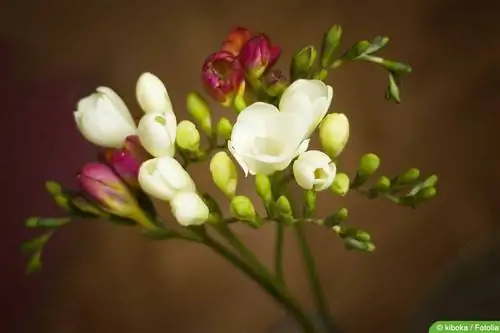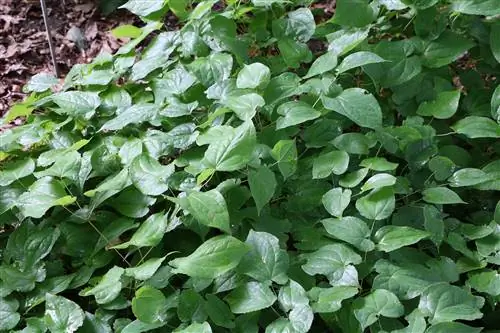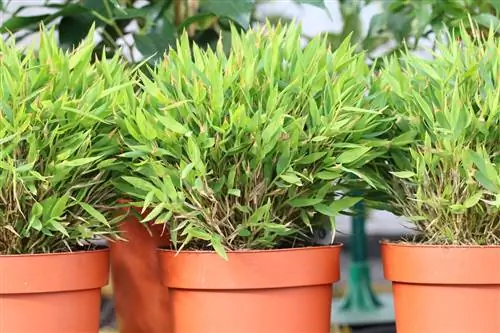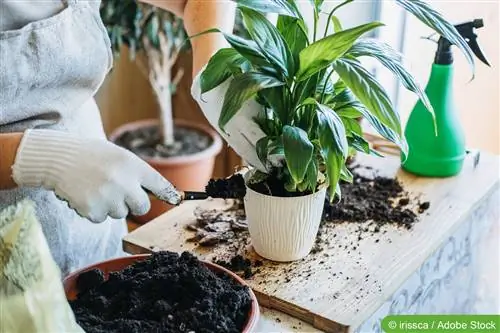- Author admin [email protected].
- Public 2023-12-17 03:39.
- Last modified 2025-06-01 06:48.
Freesia is the ideal plant for beginner gardeners. It is not demanding to care for, it just needs to be watered regularly. Hobby gardeners are rewarded with lush blooms in late summer.
Profile
- Family: Iris family (Iridaceae)
- Occurrence: Regions of Africa with winter precipitation
- Height: 25 - 40 cm, some varieties up to 100 cm
- Growth habit: upright, narrow
- Leaves: green, narrow, upright
- Flower shape: funnel-shaped, slightly fragrant, up to 8 cm long
- Flowering time: August - October
- Flower colors: white, yellow, orange, red, violet, blue, multicolored
- Winter hardiness: not hardy
- Use: bedding plant, potted plant, cut flower
Location
The Freesia is a sun worshiper and thrives best when it receives as much light as possible. It thrives best in partially shaded places, but is already less flowery there. It also has no resistance to the intense midday heat, provided it can compensate for the loss of moisture through the leaves by absorbing water through the roots. In full sun locations, permanently moist soil is therefore essential.
Soil and substrate
If the freesia is planted outdoors, where it feels most comfortable, it is undemanding. As a rule, normal garden soil is sufficient for them to bloom beautifully. The pH value of the substrate should be neutral to slightly alkaline. Freesia only tolerates lime to a limited extent.
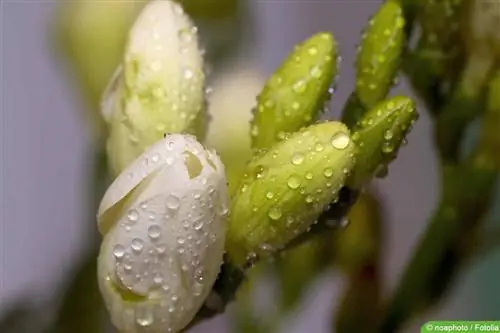
If you want freesias to bloom particularly richly, you should pay attention to the following soil properties:
- permeable
- humos
- slightly moist
Plant the freesia in a pot or trough, paying particular attention to mixing the soil with substrate that can store water well and release it back into the environment. For example, lava granules or expanded clay are suitable for this.
Note:
Although the freesia likes it to be constantly moist, it does not appreciate waterlogging. Therefore, especially when growing in a pot or bucket, make sure that the bottom layer is a drainage layer made of expanded clay.
Planting time
Specialist retailers often sell pre-grown or already blooming freesias. The onions are also sold in early spring and can be planted outdoors from mid-May. If you buy tubers early, you should keep them dark and not too warm. Room temperature is usually already too high.
Tip:
One to two weeks before you want to plant the bulbs, you should spray the tubers with water or briefly bathe them repeatedly in lukewarm water. This can accelerate sprouting after planting.
Planting
Before planting the freesia, loosen the soil thoroughly. This can be omitted if you prepare the soil or pot with fresh substrate. The bulbs are planted 5 - 10 cm deep. Make sure you give the freesia enough space. For smaller varieties, a distance of 10 cm is sufficient; varieties that can grow very large should be at least 20 - 30 cm away from the next plant.
Freesias also work very well as solitary flowers, but they look best when planted in color-coordinated individual groups.
Pouring
Drought quickly becomes a problem for the freesia and it leaves everything hanging or can even drop the flowers prematurely. Therefore, water the plants regularly, especially if it has not rained for a long time. For cultures in pots, you may even have to water at least once a day.
Freesia does not appreciate temperature shock when watering. Therefore, avoid using water directly from the tap and instead use tempered water. You can either use rainwater collected in barrels or pour water from the tap into a watering can and leave it for several hours so that it adjusts to the ambient temperature.
The ideal time for watering is the morning or mid-morning. You should not water the freesias during the hottest midday heat, unless there is an acute emergency in which the substrate has dried out and the plants are already hanging their heads.
Fertilize
Freesia likes nutrient-rich soil, but basic fertilization with organic long-term fertilizer is sufficient for it. Mature compost is sufficient as an organic fertilizer, but you can also use commercially available fertilizer pellets that you work into the soil or mix into the substrate. As soon as the plants bloom, you can fertilize regularly with an emphasis on potash. This has a positive effect on the flowers and means they last longer and the plants bloom more luxuriantly.
pruning
Pruning is usually not necessary with freesia. It produces flowers continuously until the end of the season. However, you can remove spent flowers and cut back the remains so that they do not produce seeds. The formation of seeds would cost it unnecessary energy, which would affect the plants' ability to flower.
Freesias are not poisonous to humans, so you do not need to take any safety precautions when removing flowers. Things are a little different for dogs and cats; the plants are poisonous to them.
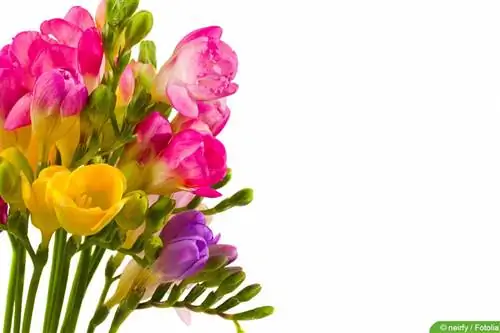
Use the freesia as a cut flower, making sure to cut the stem close to the ground. This saves the plant a lot of energy, as it does not have to supply any remaining flowering stems.
Propagation
Freesia produces spherical capsule fruits, provided the plants have been pollinated. The fruits contain brown seeds that are shiny. However, outside of their natural distribution areas, freesias rarely reach fruit maturity. Due to the late flowering time from August onwards, seeds can only ripen if the plants are protected over the winter.
Instructions for propagation via seeds:
- Remove seed pods from completely dried flower stalks
- Let seeds dry for a few days
- Keep seeds dry
- Let seeds soak for 24 hours in early spring
- sow the next day in a soil-sand mixture
It is easier to propagate via brood tubers. You can find these in the fall when you dig up the freesias for overwintering right next to the mother tuber. After a few years, the mother tubers are no longer so flowery and should generally be replaced by younger tubers.
You can recognize the breeding tubers because they hang on the side of the mother tuber or have already come loose. However, it takes several years until the breeding tubers produce the first flowers.
Diseases
Exotic plants like freesia are often affected by special plant diseases that they bring with them from their homeland. This also includes the freesia mosaic virus. In general, plants are susceptible to mosaic viruses. In addition to a special type that only affects this type of plant, the bean mosaic virus can occasionally also occur. However, this is far less problematic than the special freesia mosaic virus, which causes the leaves to turn brown and the plants only produce deformed flowers.
In both cases, the plants can usually no longer be helped. In the early stages you can try to cut the plants back generously, but if the infestation is too large, you should dispose of the freesia in the trash. This also applies if the plants are affected by tuber rot. The plants then wilt and die within a short time.
In this case you should even generously remove the substrate. If you are growing in a pot or trough, you should sterilize the containers.
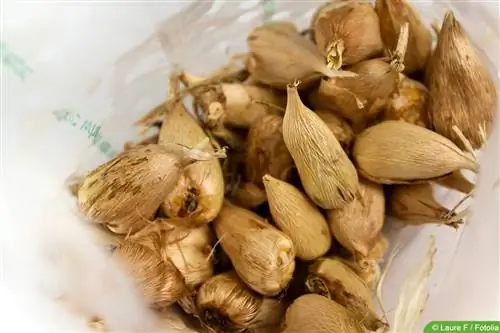
Bulb rot as well as gray mold occur when it is wet for a long time and leaves or soil are constantly moist. The freesias like it to be constantly slightly moist, but they cannot tolerate too much moisture. In both cases, drainage is also helpful in the garden soil, which tends to become waterlogged, and a sunny location so that the leaves can dry out.
Pests
Aphids and voles are the main problem for freesia. The aphids pose a double danger as they are the main vector for the mosaic virus.
If you have an aphid infestation, you should act as follows:
- Dissolve 50 g of soft soap in 1 L of warm water
- Let the solution cool down
- spray affected plants generously with it
- repeat every two to three days
In addition, you should promote beneficial insects in your garden in the fight against aphids. Aphid larvae eat several hundred aphids per day and are therefore a valuable weapon against these harmful insects.
A problem when planting outdoors are voles, for whom the tubers are also not poisonous. Especially when the freesias simply don't want to grow, they often fall victim to voles. If there is a risk of voles in the garden, you should not plant the tubers without protection. There are special plant baskets in which you can put the tubers and which the voles cannot gnaw through. As a rule, the tubers are safe in them and these baskets have the advantage that you can simply lift the tubers out of the ground for overwintering.
Wintering
If the temperatures get cooler again, the freesia will usually move in on its own. You can easily overwinter as a tuber in a cool, frost-free place, for example in the cellar. In the open field, the tubers usually freeze when temperatures are just a few degrees below zero, because the plant is not hardy.
Wintering instructions:
- Cut off flower and leaf residues
- Carefully remove tubers from the ground
- Carefully remove soil
- Place tubers in a box filled with sand
- Spray tubers occasionally with water in winter
The tubers can be planted out again from mid-May. Growing in an unheated greenhouse is not recommended. The freesia is particularly susceptible to disease there, and because it is not winter hardy, late frosts, when even the temperatures in the greenhouse drop sharply, can damage the plants.

